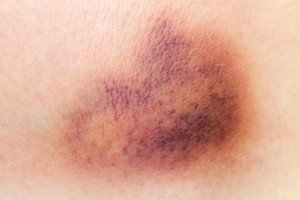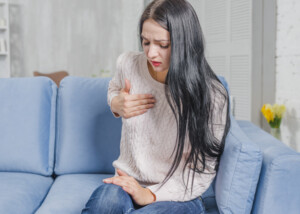An especially aggressive form of breast cancer can cause the appearance of bruising on the breasts.
So how do you tell the difference between the bruise-like area of this kind of cancer and that of a benign bruise from skin trauma?
“This sign tends to happen in a less common and aggressive forms of cancer called inflammatory breast cancer, and the skin change is caused by the tumor cells blocking proper lymphatic drainage in the skin,” explains Mylaine Riobe, MD, founder of Riobe Institute of Integrative Medicine.
Dr. Riobe, board certified in OB/GYN and integrative medicine, is the author of “The Answer to Cancer.”
“It can also make the skin appear like an orange peel and this is called “peau d’orange,’” says Dr. Riobe.
A bruise from skin trauma (e.g., bumping into something, getting bumped into, impact from a ball, child’s playful hand, or adult hand in a karate class) follows a predictable course.
The skin that covers the breasts is no different than the skin that, say, covers your legs.
A bruise on your breast from an external source will progress and appear the same as bruises on your legs, butt or arm.
Bruising from External Trauma
- 0-2 days: pinkish or “red”
- 2-5 days: blue and/or purple
- 5-7 days: green
- 7-10 days: yellow

Normal bruise. Shutterstock/Stephane Bidouze
It can take about two weeks for a typical bruise to vanish, though big “ugly” ones from more forceful trauma will take longer – but they’ll still follow a predictable course.
Inflammatory breast cancer affects one percent of all BC cases in the U.S. yearly. This means about 2,300 new cases/year, making it a rare disease.
Bruise of Inflammatory Breast Cancer vs. Benign Bruise
Inflammatory breast cancer can visibly progress over a matter of days, even hours.
It’s not likely that a bruise on your breast that’s progressing according to the color guide above is a sign of IBC.
The bruise as the only symptom – over a period of time – is a reassuring sign, but keep an eye on it to see if it does – or doesn’t – follow the color progression of a harmless bruise.
If it’s still there after two weeks and doesn’t seem to be following the color progression, AND if it’s gotten bigger for no apparent reason, see a doctor.
Other Symptoms of Inflammatory Breast Cancer
• Redness covering a large surface area of the breast; may come and go.
• Swelling, which may involve only part of the breast.
• Unusual warmth, aching or tenderness.
• Appearance of hives, welts or bug bites.
• Unusual inversion or flattening of the nipple.
• Any other frightening (usually sudden onset) appearance of the skin, including a surface that resembles an orange peel.
Trust your gut if you begin feeling uneasy at what you’re seeing. It’s reassuring if you recall a recent collision of something with your breast.
Keep a close eye on any new bruise for suspicious changes.
Inflammatory breast cancer is sometimes misdiagnosed as eczema! Get a second opinion if this is your diagnosis and your gut is doubtful.

Dr. Riobe has helped thousands of patients overcome difficult illnesses by addressing root causes, not just masking symptoms. The Riobe Method focuses on the prevention of disease, not the prevention of death from disease. She has 20+ years’ experience using integrative techniques to treat diverse patients.
 Lorra Garrick has been covering medical, fitness and cybersecurity topics for many years, having written thousands of articles for print magazines and websites, including as a ghostwriter. She’s also a former ACE-certified personal trainer.
Lorra Garrick has been covering medical, fitness and cybersecurity topics for many years, having written thousands of articles for print magazines and websites, including as a ghostwriter. She’s also a former ACE-certified personal trainer.
.
Top image: ©Lorra Garrick
Source breastcancer.org/symptoms/types/inflammatory/symptoms brui
Discomfort Behind Breast when Swallowing: Cancer May Be Cause



























